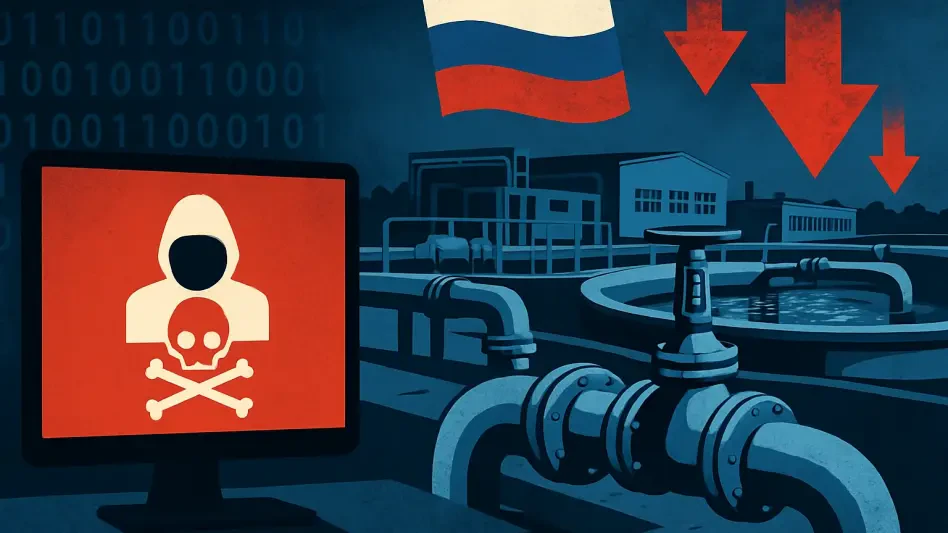Imagine a small town waking up to find its water supply completely shut down, not by a natural disaster, but by an unseen enemy thousands of miles away, striking through digital means. This chilling scenario is becoming a stark reality as cyberattacks on water and wastewater systems escalate across the globe, with fingers pointing toward Russian state-linked actors as key perpetrators. Critical infrastructure, once thought to be beyond the reach of digital threats, now stands vulnerable in an era of cyber warfare. This roundup article delves into the rising tide of cyber threats targeting water utilities, gathering insights and opinions from various industry perspectives to uncover why these systems are under siege, what vulnerabilities enable such attacks, and how nations can respond to safeguard this essential resource.
Unveiling the Threat: Water Systems as Cyber Battlegrounds
The importance of water systems cannot be overstated—they are the lifeblood of communities, supporting everything from daily household needs to industrial operations. Yet, recent incidents in countries like Norway and Poland have revealed how these vital assets are becoming prime targets for cyberattacks, often attributed to Russian hackers. Industry observers note a disturbing trend where nation-state actors exploit these systems not just for disruption, but to send a geopolitical message, especially amid tensions tied to conflicts like Russia’s actions in Ukraine.
Diverse viewpoints emerge on the severity of this threat. Some cybersecurity analysts argue that water utilities are low-hanging fruit due to their often outdated technology, making them attractive for attackers seeking maximum impact with minimal effort. Others, however, stress that the intent behind these attacks—such as releasing massive water flows from a dam in Norway—appears more focused on instilling fear than causing lasting physical damage, a tactic seen as psychological warfare.
A broader consensus points to an urgent need for awareness. Reports indicate that such incidents are not isolated, with similar pressures felt by utilities in multiple regions. This growing recognition among experts underscores the importance of understanding both the technical and political dimensions of these attacks, setting the stage for a deeper exploration of specific cases and systemic weaknesses.
Examining the Cyber Onslaught on Water Infrastructure
Russian Hackers and the Strategic Use of Water
Incidents in Norway and Poland have spotlighted the role of Russian state-linked actors in targeting water infrastructure. In Norway, a dam attack saw hackers allegedly release significant water volumes over several hours, an act interpreted as a demonstration of capability rather than outright destruction. Similarly, Poland faced threats to a major city’s water supply, raising alarms about potential shutdowns that could cripple urban life.
Opinions vary on the motivations driving these actions. Some security professionals believe these attacks are direct extensions of cyber warfare, tied to broader geopolitical conflicts and meant to destabilize nations opposing Russian policies. Others suggest a more nuanced strategy, where water systems serve as symbolic targets to project power and test the resilience of adversarial states without escalating to physical conflict.
The debate also touches on response mechanisms. Certain industry voices advocate for stronger international sanctions and diplomatic measures to deter such aggressions, while a contrasting view emphasizes the need for technical fortifications over political posturing. This divergence highlights the complexity of addressing threats that blend digital and diplomatic arenas.
Global Reach: Water Systems Targeted Worldwide
Beyond Europe, the United States faces its own share of cyber pressures on water utilities. Data from industry networks reveal that a significant percentage of surveyed systems—roughly 19%—encountered cybersecurity incidents in the early part of this year. A notable case in Massachusetts involved a foreign threat group maintaining access to a utility’s network for an extended period, hinting at long-term espionage rather than immediate disruption.
Perspectives on this global phenomenon differ. Some experts view these prolonged intrusions as preparatory steps for future attacks, where adversaries gather intelligence to strike at opportune moments. Others argue that such persistence reflects a shift toward strategic patience, contrasting with the more immediate, disruptive tactics seen in ransomware campaigns of recent years.
International cooperation emerges as a key discussion point. While certain analysts push for shared intelligence and joint defense initiatives to counter these borderless threats, skepticism remains about the feasibility of such collaboration given differing national priorities. This tension illustrates the challenge of uniting against a common digital enemy.
Systemic Flaws: Why Water Utilities Remain Vulnerable
Water systems often operate on aging infrastructure, with outdated firmware and unsecured remote access points like Telnet creating easy entryways for attackers. Cybersecurity specialists highlight that many utilities, especially in rural areas, lack the funds to modernize, leaving them exposed to even basic hacking techniques such as exploiting default passwords.
Regional disparities fuel varied opinions on solutions. Some industry advocates call for federal intervention to provide financial and technical support to under-resourced utilities, arguing that national security hinges on the weakest links. Conversely, others propose grassroots efforts, pointing to volunteer-driven programs that pair experts with small systems to implement fundamental security measures at low cost.
A middle ground also surfaces, with suggestions that basic cybersecurity hygiene—such as regular updates and network segmentation—can significantly reduce risks without requiring high-end technology. This pragmatic approach garners support from those who believe incremental improvements can build resilience, even in resource-constrained environments.
Evolving Threats: From Financial Gain to Geopolitical Power
The nature of cyber threats to water systems has shifted over time. While ransomware dominated attack patterns in the initial years starting from 2025, recent insights suggest a pivot toward nation-state objectives, where water becomes a pawn in larger power struggles. Russian, Iranian, and Chinese actors are often cited as key players in this strategic game, each with distinct goals.
Differing analyses emerge on what drives these actors. Some cybersecurity researchers argue that Russian efforts focus on disruption as a political tool, while Chinese tactics lean toward espionage for long-term leverage. Iranian approaches, meanwhile, are seen by some as blending ideological motives with technical sabotage, creating unpredictable risks.
Speculation about future threats also varies. Certain experts warn of hybrid attacks that combine digital intrusions with physical consequences, potentially amplifying societal impact. Others caution against over-emphasizing complex scenarios, instead urging focus on fortifying against known vulnerabilities as the most immediate priority.
Building Defenses: Strategies to Protect Water Systems
Insights from multiple sources converge on the need for robust defenses to shield water infrastructure from cyber threats. Recommendations include adopting standardized security frameworks that prioritize inventorying devices, securing configurations, and continuous monitoring. These foundational steps are seen as accessible even to smaller utilities with limited budgets.
Funding remains a contentious issue among industry commentators. A segment of thought leaders pushes for increased federal and state grants to bolster cybersecurity, citing water systems as critical to national stability. An alternative perspective favors public-private partnerships, suggesting that collaboration with technology firms could bring innovative solutions to the table without straining public coffers.
Empowering local communities also garners attention. Some voices advocate for grassroots advocacy, encouraging citizens to demand security assessments of their local utilities. Others highlight state-led regulations as a way to enforce consistent standards, ensuring that no system falls through the cracks in this escalating cyber conflict.
Reflecting on Water Security: Lessons Learned and Paths Forward
Looking back, the discussions and insights gathered paint a sobering picture of water systems as emerging battlegrounds in cyber warfare, with Russian actors often at the forefront of these digital assaults. The varied opinions—from the geopolitical intent behind attacks to the stark vulnerabilities in infrastructure—underscore a shared urgency among experts to act decisively. The global scope of the threat, coupled with evolving tactics of nation-states, demands attention from all corners of society.
Moving ahead, stakeholders are encouraged to explore actionable solutions, such as supporting initiatives that pair volunteer expertise with vulnerable utilities. Governments and communities alike need to prioritize funding and regulatory frameworks to close security gaps. Further exploration of international alliances could also offer a pathway to counter these borderless threats, ensuring that water, a cornerstone of life, remains protected against the unseen dangers of the digital age.








